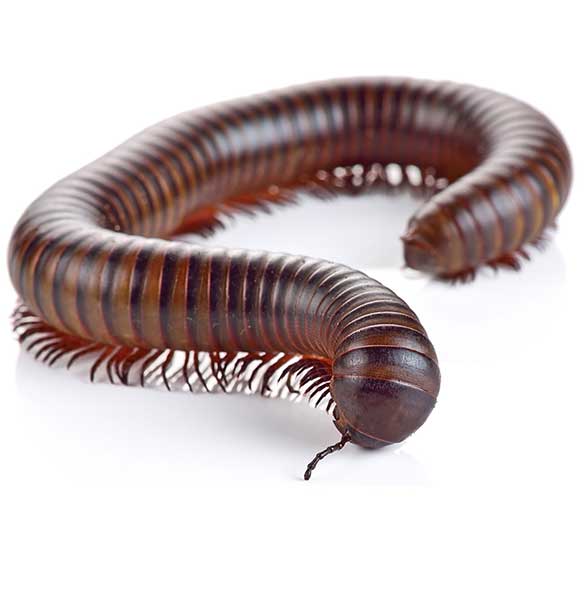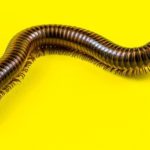Welcome To Our Millipede Learning Center
MillipedesMillipedes are characterized by having two pairs of jointed legs on most body segments. Each double-legged segment is a result of two single segments fused together. A hatchling is born with only three pairs of legs and can grow up to 200 as an adult.
(Myriapoda diplopoda)
Description
Millipedes are invertebrate animals often confused for centipedes. They are arthropods that belong to the class Diplopoda. Contrary to popular belief, they are not insects but are more closely related to centipedes and crustaceans. They can vary in size from about 1/2 inch to more than 6 inches in length. They are generally easy to identify, as they are dark brown or black in color.
Despite their name, millipedes do not have one thousand legs. The number of legs varies depending on the species, but most millipedes have between 30 and 400 legs. Millipedes have a cylindrical body that is divided into many segments. The number of segments can vary greatly, with some species having over 400 segments. Each segment of their body has two pairs of legs.
Millipedes are found on every continent except Antarctica.They are found in every U.S. state, including Alaska and Hawaii. They inhabit a wide range of habitats, including forests, grasslands, deserts, and caves. They prefer dark, moist, protected areas such as under stones, rotted logs, leaves, and bark.

Additional Information
Millipede Behavior
 Millipedes are generally slow-moving creatures that spend most of their time on the ground, although some species can climb trees and plants. Millipedes are detritivores, which means they primarily feed on decaying plant material, dead insects, and organic matter in the soil. They play an important role in the decomposition process, helping to break down organic matter and recycle nutrients back into the ecosystem. Millipedes have simple eyes and do not have great vision. They rely on touch and chemical senses to navigate their environment and locate food. Millipedes aren’t fast, so they cannot outrun their predators. They do not have much to rely on for defense against predators except for their hard exoskeleton. When a millipede feels it is in danger, it will coil its body into a tight spiral to protect its belly.
Millipedes are generally slow-moving creatures that spend most of their time on the ground, although some species can climb trees and plants. Millipedes are detritivores, which means they primarily feed on decaying plant material, dead insects, and organic matter in the soil. They play an important role in the decomposition process, helping to break down organic matter and recycle nutrients back into the ecosystem. Millipedes have simple eyes and do not have great vision. They rely on touch and chemical senses to navigate their environment and locate food. Millipedes aren’t fast, so they cannot outrun their predators. They do not have much to rely on for defense against predators except for their hard exoskeleton. When a millipede feels it is in danger, it will coil its body into a tight spiral to protect its belly.
In the spring, millipedes lay between 20 and 300 eggs in the soil. The eggs hatch in several weeks. Young millipedes have only the first three pairs of legs and no more than seven segments. Millipedes are long-lived and can live for up to 10 years.
Are Millipedes Harmful?
Garden millipedes do not typically harm plants. In fact, they are like earthworms in that they rejuvenate the soil. Because they feed only on decaying organic matter, they typically do not harm living plants unless the soil dries out to the point that the millipedes then feed on roots to obtain moisture. When they become overly abundant, they can sometimes damage seedlings as well as soft-stemmed plants in gardens.
Millipedes are generally harmless to humans, as they do not bite or sting. However, some species have defensive mechanisms to protect themselves from predators. They can secrete foul-smelling chemicals from glands along their body, which acts as a deterrent. These chemicals may cause skin irritation or allergic reactions in some individuals. Therefore, it is advised to avoid handling millipedes with bare hands. Use gloves and wash hands thoroughly after coming into contact with them.
Controlling Millipedes
Large numbers of millipedes often occur in Texas during wet springs. In fact, many areas in Texas are known for millipede infestations. Their numbers have been on the rise in recent years as the weather has become favorable for these pests.
Millipedes may be found inside homes or other buildings when there are adverse weather conditions or lack of food. Millipedes are often located in damp areas near washing machines or sump pumps.
To control millipedes, it’s best to remove objects that provide hiding places for them outside the home. This means eliminating trash piles, leaf piles, rocks, boards, compost piles and similar materials from around the home. Get rid of debris and trim your grass and bushes.
It’s also a good idea to physically exclude millipedes from entering the home. Make sure doors and windows fit tightly. Any cracks and crevices should be caulked to prevent millipedes from entering the home or building. Any foundation cracks and gaps just above the foundation should be sealed as well.
If you see a couple millipedes in your home, it is likely due to a moisture issue, as they prefer damp areas. Keep your floors dry. Fix any leaks in sinks in bathrooms and kitchens. Outdoors, you will likely see millipedes near gardens and pools.
If you see a few millipedes in your living space, you may be able to quickly get rid of them by vacuuming them up and picking them up with gloved hands. Some people stomp on them or use insect sprays and repellents.
However, if millipedes are found in or around your home in great numbers or are creating problems, it’s best to seek extermination. If you’re seeing a lot of millipedes indoors, you likely have a large infestation outside of your home. This is a situation in which Stride Pest Control can help. Our Austin pest control professionals can help you get rid of millipedes and other pests quickly and easily. Our team offers the best possible service in the nicest possible way.
Contact Us Today
Millipedes are not typically dangerous to plants and humans, but it’s still a good idea to keep them out of your home, yard, and business. Their appearance can be frightening to some people and if threatened, they can produce cyanide to defend themselves. This can cause skin irritation and burns.
You don’t have to deal with millipedes on your own. Get professional help from Stride Pest Control. We’ll help eliminate millipedes and other pests from your home and yard. Get peace of mind from insect problems. To schedule a free inspection with Stride Pest Control, call (512) 777-1339 (Austin) or (210) 547-8410 (San Antonio) or fill out the online form.
Average Number of eggs laid by female millipedes
100+
Most legs ever counted on one millipede
750
Pairs of legs a millipede is born with
3
Pairs of legs per body segment
2
GET A FREE CONSULTATION TODAY!
Get a FREE Consultation

